FILMS BY LEANDRO KATZ |
|
|
|
CROWD 7X7
14 min, black and white, silent (l974, released 1976) A large gathering of people is examined in seven different optical treatments. |
 |
| "An overhead
camera pans ever so slightly and within a severely restricted range above
a large gathering crowd in Quito, eagerly awaiting the unveiling of an image
of Christ because of a rumor that its face had been redone to resemble Che
Guevara. The occasion of the gathering is not specified within the film.
The subject of the crowd itself --an impersonal mass being observed via
a seemingly omniscient camera-- leads the spectator to think about his or
her relation to the crowd being observed."
Tony Pipolo, Millennium Film Journal, © December 1980 |
|
|
|
LOS ANGELES STATION
l0 min, 16mm, color, silent (l970, released 1976)) Portrait of a small community living by the railroad tracks in the banana plantation region of Quiriguá, Guatemala. Originally a single take, this film is composed of alternating equal number of moving frames and frozen frames as the camera tracks alongside the train station. |
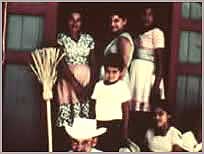 |
| "Los Angeles
Station is Leandro Katz's simplest, most direct and probably least ambitious
film and yet in many ways it is his loveliest. The results of the systematically
structured material is unexpectedly stirring. Because of the impersonal
method of construction, the freeze frames are not the result of sudden sentimental
tugs. The count sometimes falls very conveniently on an image of natural
poses, strikingly set against the backdrop; but just as often, the freeze
frame is of a bare wall or an alleyway. The mechanical tension between the
handheld camera's panning and the systematic stops creates disarmingly simple,
evocative effects. The freeze may halt a pan or simply congeal an already
held moment. In the first case, an image often ends up de-centered, highlighting
the broadside of the shack-like dwellings with their inhabitants crowded
at the edge. Or, alternatively, a smiling boy, full of animate life and
sensuousness, suddenly becomes an anthropological document, frozen evidence
of a time, a place, and a culture."
Tony Pipolo,
Millennium Film Journal, © December 1980 |
|
|
|
TWELVE MOONS
(& 365 SUNSETS) 29 min,, toned black and white Super 8, audiotape in installation version, (l976) With the voices of Kathy Acker, Peter Gordon, Ted Castle and Judith Hendra. |
 |
"The series of
films of the moon (Twelve Moons, Moonshots, Moon Notes, and The Judas Window)
were my first political films. I wanted the audience to hold hands while
watching them, searching for a sense of a real community gathered to reflect.
In these I was merging associations about cinema and the moon being the
first projection screen, with my interest in ancient Maya astronomers and
their obsession with celestial signals." L.K.,
notes. 365 Sunsets is a series of Polaroid Professional 4”x5” photographs taken with an octoculate camera. |
|
|
|
MOONSHOTS
l7 min,, 16mm, color, silent (l976) Toned, black and white and color studies of the moon in full and crescent stages filmed with time-lapse devices and telescopes of varying magnitudes. |
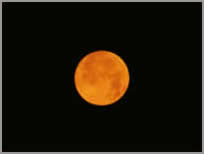 |
|
|
|
THE SHADOW
20 min,, 16mm, color, silent (1976)
|
 |
| "A view
from a window across the street from Pennsylvania Station during the early
morning rush hour. At first, the slow camera speed and the overhead angle
render all the passersby mechanical, like so many wind-up toys on a display
counter. But, as the speed gradually becomes more normal, we distinguish
between kinds of walkers; we begin to observe how people are dressed and
we conclude that it must be a warm season, perhaps Spring. These rather
elementary observations preoccupy us until something totally unexpected
happens. About a third of the way into the film, a man suddenly curls up
on the sidewalk and remains motionless. A few pedestrians stop by to see
if he is all right, but none for too long. A few moments later a wagon arrives,
men in white come and carry the man off. There, in the midst of a random
view of a city street, the camera has witnessed the stuff of TV hospitals
and police shows. We are reminded that city life is teeming with similar
unpredictable incidents, and that the germ of narrative itself is embedded
in the everyday. What is interesting about this incident is that it throws
off the focus of the film. Adjustments in camera distance, when it zooms
back, reveals the foot of the filmmaker resting on an open window sill as
he films. The sunlight gradually cuts across the image creating, quite literally,
a shadow. But these reminders of the film apparatus, the filmmaker's presence
and other components, remain ironically outside the scene just witnessed.
The title The Shadow, also takes on possible metaphorical meanings in that
the incident has disturbed the tranquility and formal symmetry of the film's
design."
Tony Pipolo, Millennium Film Journal, © December 1980 |
|
|
|
FALL
10 min,, 16mm, color, silent, with a brief musical passage by D'Indy at the end.(l977) An approaching runner constructs the suspenseful event of passing by. A study of the relations between the camera shutter and the intermittent image of the runner. With Tim O'Sullivan
|
 |
| "The structure
of Fall resembles that of a three-act drama. The first act begins with some
lovely lyrical shots of autumn foliage. Next, we see an extreme long shot
of a winding road through a wooded landscape. We discern a figure at first
far off, running towards us, up to the camera and past. Then, in the entire
center section of the film, the camera, mounted n a car driving alongside
the runner, plays a kind of game with the running 'protagonist,' teasing
the spectator by panning back and forth within a very narrow range of close-ups
but never going beyond a composition which is entirely fixed at the top
frame line at a point just above the runner's knees. When the camera pans
right, the runner is pushed to the far left edge of the frame so that most
of him is outside the frame. Since we cannot see both legs within the frame
at the same time, it appears that we are only seeing one leg engaged in
a strange tapping motion as it hangs inside the frame. And when the camera
pans left, the runner is pushed to the far right edge of the frame, and
seems to be dangling one leg clownishly inside the frame. What we see is
not fully the intelligible act of running but a collection of disembodied
parts being 'animated' by the camera's various mechanical gestures."
Tony Pipolo, Millennium Film Journal, © December 1980 |
|
|
|
PARIS HAS CHANGED A LOT
21 min,, l6mm, color, sound, film for a reclined projector and a vertical screen (l977) Music by Richard Landry |
 |
| "The
camera is placed on the grassy mound between he uptown and downtown lanes
of Park Avenue just south of the underpass which goes through the center
of the Avenue as an approach to Grand Central Station. We are not aware
of the position of the camera until the very end, for the film opens on
a close telephoto view of the sculptured facade of Grand Central against
a blue sky. As distance changes, we get fuller views of the station, the
buildings, the entrance to the roadway which encircles the station, and
then the full view of both uptown and downtown traffic lanes on Park Avenue.
Camera speed also alters from beginning to end, accentuated by the movement
of traffic toward and away from the station. At one point we are focused
on an intersection at which the traffic lights dictate the rhythms of movement.
Yet, for all the detailed familiarity of the scene --the buildings, and
the taxis, pedestrians, and bicyclists endlessly crossing the frame or moving
into and out of its depth-- we begin to feel as if we are watching a film
preserved in a time capsule from a civilization long destroyed. The defamiliarizing
is created by several factors. The acceleration of the images, of course,
turns automobiles, bicycles, people, and traffic lights into molecules of
city life. In addition, the film has a very beautiful, haunting score composed
by Richard Landry, consisting of somber chromatic tones and sounding like
the retarded movements of the Ligeti requiem mass in 2001: A Space Odyssey.
Last, but not least, the shape of the screen itself is vertical because
the projector has been turned on its side to allow the images, which have
been filmed from that perspective, to be seen rightside up."
Tony Pipolo, Millennium Film Journal, © December 1980 |
|
|
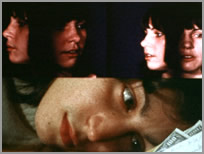 |
Selected
Bibliography:
|
|
|
|
MOON NOTES
l1 min,, 16mm, color, silent (l980) Third in a series, this film is divided into four sections: The Tortuous Nature of our Progress, The Fire-El Fuego, Distance Number of Nothing, White Rushes Tied to a Cluster of Mulberry Shoots. |
 |
| "The moon
films are the result of yearlong studies of the full moon and each is more
ambitious and more technically sophisticated than the previous one. The
filmmaker's ambition is to harness this marvelously powerful force of nature
and to place it in the theatrical arena where a gathering of spectators
could share the communal feeling that once belonged to ancient civilizations.
Certainly these long-held shots of the full moon do what no photograph can
do: they assert the living presence of the moon as an eternal object of
mystery, glowing in various colors, obscured by passing dark clouds, moving
majestically across the night sky. The sheer concentration of imagery, even
as it is transformed by the use of different film stocks and speeds, mocks
those overfamiliar metaphorical and symbolic uses to which the moon has
often been the subject. In these luminous, contemplative gazes of the camera,
the moon is rendered awesome, strange, inaccessible as it must have been
experienced in the recesses of history."
Tony Pipolo, Millennium Film Journal, © December 1980 |
|
|
|
THE VISIT
(Foreign Particles) 35mm slide sequence, 75 min., black and white, sync sound (l980) With Mark Boone Junior and José Rafael Arango |

|
| "Leandro
Katz's The Visit, a slide show with a continuous soundtrack, to be
projected on a cinema screen, tells of two men pursuing each other, as criminal
adversaries as well as sexually, but it proceeds without explaining what
the factual basis or the moral valence of their several encounters might
be. To a degree, the facts can be constituted by an alert viewer, and considered
in this way The Visit would belong in the category of oblique narratives
- narratives that are too sophisticated to tell their stories patently,
yet refer to or are clustered around a plausible, psycho-morally motivated
sequence of events. On closer inspection, however, it seems more fruitful
to waive this category here and merely attribute to The Visit a
certain indifference as to whether it suggests a reconstructible plot or
not. One element in The Visit that definitely transcends the diegesis
of its "story", is the inclusion of bits of theory. The most shocking way
in which this is done is through the use of the telephone- a piece of equipment
naturally and diegetically present in the room where the scene takes place.
The pursued character picks up the receiver and listens to a message. What
we hear/ what he hears is a semiotic text involving "the signifier" and
"the signified", a short yet aggressively taxing paragraph. Difficult to
comprehend for its lack of context and surprising unrelatedness to the events,
it is also irritating for reasons of its own, e.g. the linguistic similarity
of the two terms it sets out to distinguish. But it is in this that it vaguely
connects with the thematics of the work - the unresolved question as to
whether the distinction of the two characters as "the pursuer" and "the
pursued' is ultimately relevant. By the simple effect of being a slide show,
of consisting of still images whose duration on the screen is mainly determined
by their emotional weight and by the rhythmic development of the piece,
The Visit frees the viewer from the expectations of cinematic "realism".
No longer geared to the illusionary flow of events, each image takes on
a life of its own, representing psychological instead of cinematic time
and freezing the action, as it were, in order to make the configuration
on the screen more opaque on the one hand and more analyzable on the other.
Meanwhile, the soundtrack continues smoothly, as if synchronous to a realistically
unfolding film. It is largely the discrepancy between the steadily advancing
sound and the arrested image that incessantly keeps the viewer aware of
the aesthetics that inform the work. The viewer is thus invited to dwell
upon the decisions of the filmmaker - a quality enforced here by the necessity
of Leandro Katz's actually being present to change the slide trays according
to an intricate electronic system. And also, the viewer is invited to reflect
upon the nature of each behavioral act or emotional response presented on
the screen, as they are held up for analysis, frozen in action. This renders
a more abstract, less emotionally gratifying, yet more disturbing, persistent
quality to the piece. The Visit, although charged with violence,
rage and obsession, undercuts its alienating techniques by coming closer
to an emotionally satisfying curve of rising and falling tension. There
is a sense of closure, of the conflict having spent itself towards the ending.
But again this does not necessarily mean that this work adheres to the traditional
pattern of cinematic narrative. Its lack of a comprehensible plot, its recourse
to theory and opaqueness, its emphasis on the dramatics of the moment and
its relish in inexplicable states of passion and archetypal configurations,
all together display a divergently oriented narrative sensibility."
Mutations
of Film Narrative by Christine Noll Brinckman and Grahame Weinbren. ©
Idiolects # 12 - 1982 |
|
|
|
METROPOTAMIA
25 min,, color, four-channel sound, 16mm film for two projectors and a zig-zag screen (l982) Music by Richard Landry |
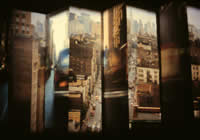 |
|
Unlike the
traditional documentary film, Metropotamia addresses several issues in
art and cinema which bring into question the spectator's position in relation
to recording of 'real' events. Simultaneous projection of two images on
a zig-zag screen force the spectator to change and thus maintain awareness
of the viewing position while attempting to occupy an advantageous point
of view that has been fragmented into three possibilities
|
Leandro Katz©1982 |
| "Leandro
Katz's film for two projectors and zigzag-folded screen, Metropotamia, is
a delirious rhapsody to city life, I big city life-which means New York
City life. The film is given structure by the passing of one day, from sunrise
to nightfall; Katz makes no attempt to rep- p resent the passage of that
time realistically, however, preferring instead to speed everything up-clouds,
traffic, people all rush by, ever faster against the looming stillness of
buildings and highways. The images are of frenetic activity and barely contained
force traffic hurtles toward the camera only to stop obediently as the light
changes; people tumble down escalators into the subway as though carried
over a waterfall; clouds swirl as though steaming from a kettle. The romantic
aspect of the film, the pleasure it takes in the look of the city and the
rhythms of its movement, is accentuated by the soundtrack, composed by Richard
Landry. The sound is that of the saxophone, establishing a mood from the
very first note. As the music progresses this mood is intensified through
the use of an electronic delay system which produces a haunting echo between
the speakers, an aural equivalent to the double projection. Which brings
us to the aspect of the I film's presentation which takes it a step beyond
the hysteria of the conventional travelogue. Two projectors, each loaded
with different reels of film, are set up in the back corners of the room,
pointing inward as well as forward at a screen which stands concertinalike
so as to accept two images. From a conventional viewing position in the
center of the room both films are visible at once, one intersecting the
other in equal portions. As one moves from side to side, one image grows
more complete as the intervening slices of the other narrow to nothing.
Katz hopes that this eccentric presentation will encourage the spectators
to become more aware of their positions as spectators, forcing them to move
around to get a better idea of the whole picture. While this is an interesting
enough notion, it is nevertheless true that it takes something more than
an oddly shaped screen to disturb the inertia of the usual consumers of
spectacle. Far more interesting than its use as a device for installing
self consciousness in its viewers is the zigzag screen's potential for extending
our understanding of montage. Here the two terms are neither superimposed
nor juxtaposed, but repeatedly inserted into one another. It is this intermingling,
almost erotic in its effect, that makes Katz's rhapsody so effective. It
abstracts from the specific details of daily life, building a rhythmic picture
of sensation, taking us from the particularities of life in New York to
a more generalized sense of the endlessly repeating movement, abrasive yet
soothing, of life in Metropotamia."
Thomas Lawson, Artforum Magazine ©1982 |
|
|
|
THE JUDAS WINDOW
l5 min,, 16mm, color, silent (l982) Part of a gallery installation of the same title, The Judas Window is divided into four sections: A Cinematographic Rain, The Urge to Save, The Mountainside and the Shoulder, Many Dancers Were Nurses. |
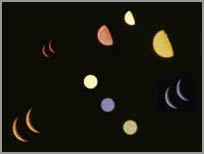 |
| "Playing with
the anticipation it activates as a screen/window, this film calls attention
to itself as an alluring sign of the possibility of vision at a secure distance.
Our fascination with looking, and cinema as a constant regenerator of the
scopophilic desire, peer back at us through The Judas Window. Continuous
images of the moon elaborate upon this question, for the moon, by virtue
of our vision and its distance, becomes an ideal location of mythic otherness,
and for the desire to possess. Five enigmatic intertitles punctuate this
series of moon images, with each section characterized by particular technical
treatment (freeze frames, slow dissolves, timing devices) and varying stages
of the moon's cycle. Shifting from images of crescent to full moons, from
single to multiple ones and from discontinuous to flowing movements, the
range of views composed ends on a significant note; extreme telescope close-ups
render the moon physical, however, in acquiring that proximity, we lose
sight of the object in its entirety. It can no longer be the moon that we
know from a distance."
Coco Fusco, The Filmmaker's Coop Catalogue. |
|
|
|
THE VISIT
30 min,, 16mm, black and white, sound (l986) With Mark Boone Junior and José Rafael Arango Cinematography: Viktor Vondracek |

|
|
|
|
REEL SIX
Charles Ludlam's Grand Tarot 8 min., 16mm, color (l987) Rare montage footage of the Ridiculous Theatrical Company with Charles Ludlam, Black Eyed Susan, John Brockmeyer, Mario Montez, Lola Pashalinsky, Ekathrina Sobechanskaya, Bill Vehr and Lohr Wilson performing Ludlam's first version of 'The Grand Tarot' in 1970. |
 |
| •Extended notes in Bedlam Days. |
|
|
|
MIRROR ON THE MOON
1:40 Color 16mm, (1992) Cast. David Warrilow, Bérénice Reynaud, Stefan Brecht and Andrew Sharp Music by David Darling |
 |
| Three enigmatic stories spiral around an elusive woman in a tale of love, death, and the obsession to decipher beguiling secrets through a labyrinth of suspenseful subplots and reflexive points of view. |
|
|
 |
| •Extended notes in main page, El Día Que Me Quieras. |
|
|
|
30 min,, digital video (2001) |
 |
| A magnificent
figure emerges from the jaws of a mythical animal carved with inscriptions.
Known as The Dragon of Quiriguá, this enigmatic stone altar is one
of the most extraordinary ancient sculptures on the continent. Spared from
deforestation during the introduction of banana plants at the end of the
nineteenth century, the seventy-five wooded acres of the Maya site of Quiriguá,
stand at the center of the Guatemalan lowlands of the South as a reminder
of how things were before the region was turned into a banana republic.
Quiriguá houses temple structures, pyramids, the tallest stelae,
and Altar P, known as The Dragon. In a quiet and reflective tone, Paradox alternates between The Dragon of Quiriguá and the feverish harvesting and processing of bananas in the immediate region, moving through a community transformed by questionable labor and trade agreements. Marked by a truculent history of colonialism connected with land appropriation, the former United Fruit Company, labor struggles, political corruption, military invasions and undercover operations, the paradox suggested by the title of this work provocatively juxtaposes our admiration of the continent's exuberant ancient past with the current conditions of the Latin American working class, both at home or in exile. •Essay by Jesse Lerner The Paradoxes of Quiriguá |
38 min,, digital video (2007) |
| Entrevista con
el médico forense Alejandro Incháurregui, miembro fundador
del Equipo Argentino de Antropología Forense (EAAF)
el cual, junto con el equipo de investigadores y antropólogos cubanos,
estuvo a cargo de hallar los restos de Ernesto Che Guevara y sus compañeros
en Bolivia, en 1997. Al cumplirse los cuarenta años de la muerte de Ernesto Che Guevara en 1967, fue imperativo retornar con “Exhumación” al tema del documental “El Día Que Me Quieras”, sobre las últimas fotos tomadas por el fotógrafo boliviano Freddy Alborta, del cuerpo ya sin vida del Che Guevara en la lavandería del Hospital Nuestro Señor de Malta, en Vallegrande, Bolivia. En “Exhumación”, Alejandro Incháurregui relata cómo el Equipo Argentino de Antropología Forense, intenta seguir los datos revelados por Mario Vargas Salinas, el general retirado de las Fuerzas Armadas Bolivianas, quien, a pesar de las presiones militares, decide declarar ante el periodista Jon Lee Anderson, del New York Times, el paradero de la tumba clandestina del Che Guevara. Incháurregui concentra su narración en los intentos fallidos de 1995, y en la nueva búsqueda y final hallazgo del los restos del Che y sus compañeros, en 1997, en colaboración con sus colegas argentinos Patricia Bernardi y Carlos Somigliana, y con el apoyo preliminar del equipo de antropólogos forenses cubanos bajo la dirección de Jorge González Pérez. Este documental encara asimismo detalles sobre el hallazgo de los restos de Tania, La Guerrillera, así como el concepto de “la fotografía como trofeo de guerra”. Sobre estos temas, “Exhumación” revela cómo los militares bolivianos se apoderaban de los efectos personales de las víctimas de la guerrilla del Ñancahuazú, para luego crear un mercado internacional de fetiches y de fotos tomadas por los mismos guerrilleros durante la trágica campaña del Che en Bolivia. A través de su entrevista, luchando por mantener su objetividad científica, Alejandro Incháurregui, nos permite entrever su pasión por el compromiso con los eventos que marcaron a su generación, y por su dedicación profesional como antropólogo forense, concluyendo que ‘en uno, estábamos exhumando a miles de jóvenes quienes se habían comprometido con los ideales del Che, y que hoy son “los desaparecidos” en la historia de la guerra sucia en la Argentina’. |
BLUEBEARD |
 |
| The famous seduction of Miss Cubbidge, with Lola Pashalinski in a rare audio recording, with Charles Ludlam and Lola Pashalinski, 1970 performance. Audio and photographs by Leandro Katz. |
LOST HORIZON /HORIZONTE PERDIDO |
 |
| Instalación en vértice para dos proyectores digitales, sonido. |
ROMBO - RHOMB |
 |
Photographs of a crowded street corner in Santiago de Chile are recomposed through a series of geometric patterns while examining the language of the dead time of waiting for the traffic light to change. Fotografías de una multitud en una esquina de Santiago de Chile son recompuestas a través de una serie de formas geométricas examinando el lenguaje del tiempo muerto mientras se espera que cambie la luz del semáforo. |
A LOVE FOR 3 OR 4 ORANGES |
 |
In a street corner in Buenos Aires, an extravagant character, dressed in bright colors and wearing his invented costumes, appears every afternoon to salute the world. 'A Love For 3 or 4 Oranges' is an homage to several Argentine myths, and a reference to the theater through Tragedy, Drama, Comedy and Farse. En una esquina de Buenos Aires, un personaje extravagante vestido con colores brillantes y luciendo sus disfraces inventados, aparece todas las tardes para saludar al mundo. 'Un amor por 3 o 4 naranjas' es un homenaje a varios mitos argentinos, y una referencia al teatro a través de la Tragedia, el Drama, la Comedia y la Farsa. |
THE ABSOLUTE ENCYCLOPEDIA |
The Absolute Encyclopedia, The Bridge: Chorus quoted from The Order of Things, Speaking, by Michel Foucault - Roosevelt Island, New York. Camera by Tosh Ozawa, and with the voice of Judith Hendra. |
LOLA PASHALINSKI and MISS CUBBIDGE digital video, 25 mins., color, sound (2002) |
 |
Actress Lola Pashalinski talks about Charles Ludlam and The Ridiculous Theatrical Company, the famous scene from Bluebeard: The Seduction of Miss Cubbidge ( https://vimeo.com/87693838 ), and the avant-garde theatre of New York in the 60s and 70s. |
JOHN VACCARO and THE THEATRE OF THE RIDICULOUS digital video, color, sound (2002) |
 |
An interview with John Vaccaro, founder of the Playhouse of the Ridiculous, recalling the actors’ walkout during rehearsals of The Conquest of the Universe, and his friendship with Charles Ludlam. |
OS.TEN.DE (2009) digital video, color, sound |
 |
Short vignettes from the International Artists Residency in Argentina, RIAA, featuring works by many of the participating artists, woven into playful scenes filmed during an extended stay in the Old Ostende Hotel, Argentina, 2009. With references to La Invención de Morel, by Adolfo Bioy Casares, as well as other sources. |
MOUND (2024) digital video, color, sound |
 |
On the Memorial Mounds of Gyeongju |
|
For additional information: Leandro Katz |
|
|